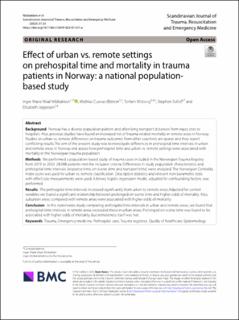| dc.contributor.author | Nilsbakken, Inger Marie Waal | |
| dc.contributor.author | Cuevas-Østrem, Mathias | |
| dc.contributor.author | Wisborg, Torben | |
| dc.contributor.author | Sollid, Stephen J. M. | |
| dc.contributor.author | Jeppesen, Elisabeth | |
| dc.date.accessioned | 2023-10-12T11:27:50Z | |
| dc.date.available | 2023-10-12T11:27:50Z | |
| dc.date.created | 2023-10-11T15:11:46Z | |
| dc.date.issued | 2023-10 | |
| dc.identifier.citation | Nilsbakken, I.M.W., Cuevas-Østrem, M., Wisborg, T., Sollid, S. & Jeppesen, E. (2023) Effect of urban vs. remote settings on prehospital time and mortality in trauma patients in Norway: a national populationbased study. Scandinavian Journal of Trauma, Resuscitation and Emergency Medicine, 31, 53 (2023) | en_US |
| dc.identifier.issn | 1757-7241 | |
| dc.identifier.uri | https://hdl.handle.net/11250/3096070 | |
| dc.description.abstract | Background
Norway has a diverse population pattern and often long transport distances from injury sites to hospitals. Also, previous studies have found an increased risk of trauma-related mortality in remote areas in Norway. Studies on urban vs. remote differences on trauma outcomes from other countries are sparse and they report conflicting results.The aim of the present study was to investigate differences in prehospital time intervals in urban and remote areas in Norway and assess how prehospital time and urban vs. remote settings were associated with mortality in the Norwegian trauma population.
Methods
We performed a population-based study of trauma cases included in the Norwegian Trauma Registry from 2015 to 2020. 28,988 patients met the inclusion criteria. Differences in study population characteristics and prehospital time intervals (response time, on-scene time and transport time) were analyzed. The Norwegian Centrality Index score was used for urban vs. remote classification. Descriptive statistics and relevant non-parametric tests with effect size measurements were used. A binary logistic regression model, adjusted for confounding factors, was performed.
Results
The prehospital time intervals increased significantly from urban to remote areas.Adjusted for control variables we found a significant relationship between prolonged on-scene time and higher odds of mortality. Also, suburban areas compared with remote areas were associated with higher odds of mortality.
Conclusion
In this nationwide study comparing prehospital time intervals in urban and remote areas, we found that prehospital time intervals in remote areas exceeded those in urban areas. Prolonged on-scene time was found to be associated with higher odds of mortality, but remoteness itself was not. | en_US |
| dc.language.iso | eng | en_US |
| dc.publisher | BioMed Central | en_US |
| dc.rights | Navngivelse 4.0 Internasjonal | * |
| dc.rights.uri | http://creativecommons.org/licenses/by/4.0/deed.no | * |
| dc.subject | akuttmedisin | en_US |
| dc.subject | traumepasienter | en_US |
| dc.subject | transport til sykehus | en_US |
| dc.title | Effect of urban vs. remote settings on prehospital time and mortality in trauma patients in Norway: a national populationbased study | en_US |
| dc.type | Peer reviewed | en_US |
| dc.type | Journal article | en_US |
| dc.description.version | publishedVersion | en_US |
| dc.rights.holder | © 2023 The Author(s). | en_US |
| dc.subject.nsi | VDP::Medisinske Fag: 700::Klinisk medisinske fag: 750::Traumatologi: 783 | en_US |
| dc.source.volume | 31 | en_US |
| dc.source.journal | Scandinavian Journal of Trauma, Resuscitation and Emergency Medicine | en_US |
| dc.identifier.doi | 10.1186/s13049-023-01121-w | |
| dc.identifier.cristin | 2183823 | |
| dc.source.articlenumber | 53 (2023) | en_US |
| cristin.ispublished | true | |
| cristin.fulltext | original | |
| cristin.qualitycode | 1 | |

